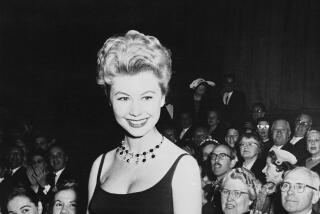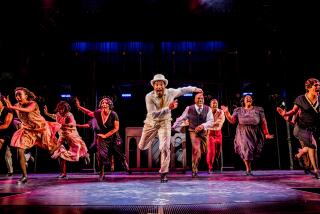BOB FOSSE: RAZZMATAZZ & A MESSAGE
- Share via
Bob Fosse, who died Wednesday night after rehearsing all day, grew up with the sound of applause. That may be why he developed a foreboding about it. His later Broadway musicals and films both celebrate the razzmatazz of show biz and point to something dark behind the glitter and the lights: graft in “Chicago,” death in “All That Jazz,” organized crime in his last, failed show, “Big Deal.”
He started out to be a hoofer. At 14 he was dancing in clubs and picking up an early education from the girls backstage. (A particularly embarrassing memory turns up in “All That Jazz.”) Like all young hoofers Fosse dreamed of being the next Fred Astaire or Gene Kelly, and when MGM called him to Hollywood in the early ‘50s, he seemed to be on his way.
But after the likes of “Give a Girl a Break” and “The Affairs of Dobie Gillis,” Hollywood decided that he wasn’t star material, only best-friend material. Fosse got the message and went back to Broadway, where he had done a few shows as a gypsy.
He had done some fiddling around with choreography on the West Coast, and this led to a job with director George Abbott, who was looking for someone to do the dances for a show called “Pajama Game.”
Abbott shows were famed for their clean, hard line. That turned out to be Fosse’s thing too. “Steam Heat” was his breakthrough number, with its snapping fingers. This came to be part of the Fosse trademark--snapping fingers, tip-tilted derbies, swivel hips, a general air of strut and sexiness that seemed to be half-kidding itself.
Audiences in the late ‘50s and ‘60s loved the sauciness of Fosse’s shows. (He was directing them now, as well as doing the dances.) Gwen Verdon, his wife for a time, exemplified the style, and “Sweet Charity” (1966) was his masterpiece for her, the story of a girl who was constantly being molested by life, but kept coming up innocent, at least by her standards. One number in “Sweet Charity” spoofed the new hippie movement, with its protests about this and that. In fact, American life was getting darker, and so was Fosse’s work. He made a stunning film of “Cabaret,” going deeper into the roots of the material than the original show had dared to do, and audiences were ready for it.
But there was something disheartening about “Pippin” (1972). It was all gimmicks, smoke bombs and and long-stemmed girls--a dazzling thing to watch, but a cynical little fable at bottom. Nobody’s heart seemed to be in it. Fosse’s wizard TV commercial spot for the show was what really drew the customers.
Fosse suffered a heart attack in the middle of rehearsals for “Chicago,” and his work grew darker still, culminating in the nightmare finale of “All That Jazz” (1979), where Ben Vereen plays Mr. Death and the big finish precludes an encore.
Even “Dancin’ ” (1978), supposedly a love letter to Fosse’s art, seemed to have a slightly mean streak, although interestingly, when Verdon restaged it for the West Coast (they were friends all the way through), it became an entirely different show.
“Big Deal” (1986) was Fosse’s big disappointment, a musical version of the film “Big Deal on Madonna Street,” which seemed to be saying, once again, that songs and dances are a cover-up for dirty work. The critics didn’t think it took the point beyond that made in “Chicago.”
Fosse’s last hit was “Sweet Charity,” revived in ’85 in Los Angeles for Debbie Allen and just as popular the next season on Broadway. Fosse was only supposed to supervise this one, but the supervision was very close.
And the show’s brass didn’t seem to have tarnished a bit. Here was the Broadway musical miraculously restored to the height of its power and confidence--fast, bright, smart and all in once piece. And its creator was still under 60. (He was working on a Washington edition of “Sweet Charity” when he died.)
“Sweet Charity” also reminded us how much Fosse influenced the most important Broadway choreographer/director to follow him, Michael Bennett. And now they are both gone. It does make you wonder if there’s anybody in the light booth.
More to Read
The biggest entertainment stories
Get our big stories about Hollywood, film, television, music, arts, culture and more right in your inbox as soon as they publish.
You may occasionally receive promotional content from the Los Angeles Times.










